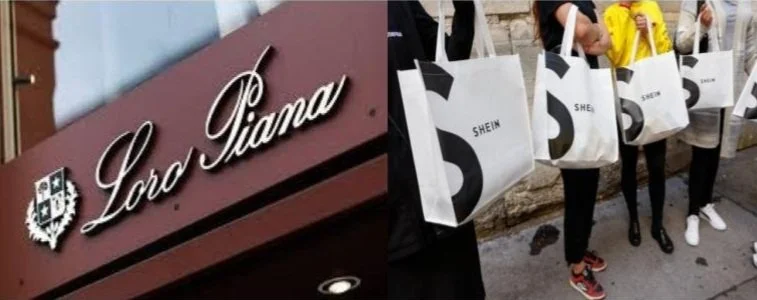France’s bill on ultra-fast fashion brands and Loro Piana’s sweatshop scandal: how to navigate the market as an ethical consumer
The French parliament recently amended a climate bill that would fine ultra-fast fashion brands, specifically Shein and Temu. France, the mecca of the fashion industry, is one of the first countries to regulate fast fashion and attempt to curtail the increasing demand of Shein. Additionally, in Italy, Italian police recently did a crackdown of the luxury brand Loro Piana, exposing its usage of illegal sweatshops on the outskirts of Milan. Loro Piana, a coveted “quiet luxury” brand and part of the LVMH portfolio, leveraged sweatshop labor to make its 800€ leather jackets. These sweatshops primarily employ illegal migrant workers who make 4€ an hour and work 90- hour weeks to produce mass goods for Loro Piana, sold between 500-1200€. Loro Piana, as well as executives at LVMH pleaded that they were “unaware” of these sweatshops. Likely, because of increased demand for luxury in the post-COVID luxury boom (especially for “quiet luxury” brands like Loro Piana), the brand needed to address mass production and ultimately decided to outsource to sweatshops to keep up with demand.
It is no secret that fast fashion brands, especially ultra-fast fashion brands like Shein, drive overconsumption and textile waste. France is attempting to address one of the root causes of overconsumption and its environmental impact by limiting visibility and advertisements from these fast fashion giants. Restricting and penalizing Shein and Temu from advertising in France will (hopefully) decrease the consumption of the poorly made, ultra-cheap products. Additionally, the French parliament fined Shein 40 million euros for advertising misleading products to consumers. According to French legislature, Shein used "deceptive commercial practices towards consumers regarding... price reductions", allowing consumers to believe that they were getting a “good deal” on products, when in reality, 11% of the advertised discounts “were actually price increases.” Restricting advertisements and visibility of Shein, as well as penalizing the brand, is a step in the right direction in terms of curtailing the impact of Shein’s massive carbon footprint.
On the other hand, the luxury sector of the fashion industry has had yet another scandal regarding the use of illegal sweatshops for mass production. Loro Piana, a luxury fashion house owned by LVMH, was caught using sweatshops on the outskirts of Milan and was placed under judicial administration on July 14. The luxury house leveraged Chinese-owned factories that exploited immigrant workers and breached several safety and labor laws. A worker from the factory was severely beaten and hospitalized for a month after asking for unpaid wages, which led to investigations by authorities and the factories being traced to Loro Piana. Unsurprisingly, the brand claimed it was unaware of these subcontractors until May 20 and ended its relationship with the supplier within 24 hours. It condemned all illegal practices and reaffirmed its commitment to human rights and legal compliance. What’s interesting about this is that a brand like Loro Piana must have a close relationship with its suppliers, especially if it needs to maintain a level of quality of its products. Loro Piana, much like other luxury brands that were recently caught using sweatshop labor — including Dior, Valentino, and Armani — likely had representatives from their brands consistently inspect the quality and manufacturing of the products to ensure that the luxury appeal was maintained for consumers. Thus, it is not possible for said brands to be “unaware” of their suppliers using illegal sweatshops to make premium, luxury products, especially when part of the brands’ appeal to consumers is maintaining the “made in Italy” quality.
As an ethical consumer, I have never shopped from Shein. I am aware of both the environmental hazards as well as the human rights violations of Shein’s labor practices, so I choose not to support it. However, as a luxury enthusiast (particularly for Italian luxury), I should expect to have transparency around Loro Piana’s (and similar brands) supply chain, especially if I’m paying 800€ for a pair of flats. According to HSBC, the cost of luxury goods has increased a whopping 52% since 2019. With the cost of labor, material, and disruptions within the supply chain throughout the pandemic, as well as the post-pandemic demand for luxury, high-fashion brands have taken the opportunity to inflate the prices of their products. If there is no difference in the quality of these premium products between 2019-now, why should I pay double? Especially when several of these brands have had scandals recently regarding their labor practices?
As a consumer, I’ve noticed myself pivoting more toward small businesses. Djerf Avenue, a brand started by Swedish influencer Matilda Djerf, has maintained transparency around its labor practices. The clothing is made in factories in Portugal, and every piece I’ve purchased through the years has retained its quality. Other small to mid-sized brands that have piqued my interest are Danielle Guizo, Mode Mischief, the Spanish brand Gimaguas, Cambell&Kramer (which uses 100% deadstock fabric for its pieces), and the more well-established With Jean (a brand that Dua Lipa frequently wears!).
Large, popular brands like Staud and Reformation are higher quality than fast-fashion brands like Zara, though they lack transparency around their supply chains and labor practices. Reformation dubbed itself as an “ethical brand,” yet it comes out with new pieces multiple times a season. Can you truly be “ethical” while encouraging over-consumption? Additionally, dozens of the pieces on Staud’s website that range between $200-300 are 100% polyester. Why should we, as consumers, spend $200 on plastic?
Over time, I’ve become more willing to spend $100–$130 on a single, high-quality item. Still, I recognize that many consumers either can’t afford that or prefer to get more for their money. The reality is, we have options: spend $70 on five fast-fashion pieces that last a few wears, or on one piece that lasts 2–3 years. The choice is ours.


